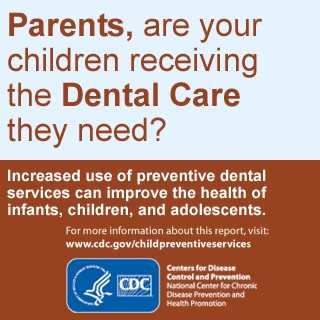Children's Oral Health

Overview
Tooth decay (cavities) is one of the most common chronic conditions of childhood in the United States. Untreated tooth decay can cause pain and infections that may lead to problems with eating, speaking, playing, and learning.
- About 1 of 5 (20%) children aged 5 to 11 years have at least one untreated decayed tooth.1
- 1 of 7 (13%) adolescents aged 12 to 19 years have at least one untreated decayed tooth.1
- The percentage of children and adolescents aged 5 to 19 years with untreated tooth decay is twice as high for those from low-income families (25%) compared with children from higher-income households (11%).1
The good news is that tooth decay is preventable. Fluoride varnish, a high concentration fluoride coating that is painted on teeth, can prevent about one-third (33%) of decay in the primary (baby) teeth.2 Children living in communities with fluoridated tap water have fewer decayed teeth than children who live in areas where their tap water is not fluoridated.3 Similarly, children who brush daily with fluoride toothpaste will have less tooth decay.4
Applying dental sealants to the chewing surfaces of the back teeth is another way to prevent tooth decay. Studies in children show that sealants reduce decay in the permanent molars by 81% for 2 years after they are placed on the tooth and continue to be effective for 4 years after placement.5
What Parents and Caregivers Can Do
Here are some things you can do to ensure good oral health for your child:
- Protect your child's teeth with fluoride.
- Use fluoride toothpaste.
- If your child is younger than age 6, watch your child brush their teeth. Make sure your child only uses a pea-sized amount of toothpaste and always spits it out rather than swallows it.
- If your child is younger than age 2, do not use fluoride toothpaste unless your doctor or dentist tells you to.
- Learn more about fluoride toothpaste and fluorides at Brush Up on Healthy Teeth.
- Talk to your pediatrician, family doctor, nurse, or dentist about putting fluoride varnish on your child’s teeth as soon as the first tooth appears in the mouth.
- If your drinking water is not fluoridated, ask your dentist, family doctor, or pediatrician if your child needs oral fluoride supplements, like drops, tablets, or lozenges.
- Use fluoride toothpaste.
- Talk to your child's dentist about dental sealants. Sealants protect teeth from decay.
- Have your child visit a dentist for a first checkup by age 1, as recommended by the American Academy of Pediatrics.
1 Dye BA, Xianfen L, Beltrán-Aguilar ED. Selected Oral Health Indicators in the United States 2005–2008. NCHS Data Brief, no. 96. Hyattsville, MD: National Center for Health Statistics, Centers for Disease Control and Prevention; 2012.
2 Marinho VCC, Worthington HV, Walsh T, Clarkson JE. Fluoride varnishes for preventing dental caries in children and adolescents. Cochrane Database of Systematic Reviews. 2013; Issue 7. Art. No.: CD002279. DOI: 10.1002/14651858.CD002279.pub2.
3 Community Preventive Services Task Force. Preventing Dental Caries: Community Water Fluoridation website. http://www.thecommunityguide.org/oral/fluoridation.html. Accessed October 23, 2014.
4 Marinho VCC, Higgins JPT, Logan S, Sheiham A. Fluoride toothpastes for preventing dental caries in children and adolescents. Cochrane Database of Systematic Reviews. 2003; Issue 1. Art. No.: CD002278. DOI: 10.1002/14651858.CD002278.
5 Ahovuo-Saloranta A, Forss H, Walsh T, Hiiri A, Nordblad A, Mäkelä M, Worthington HV. Sealants for preventing dental decay in the permanent teeth. Cochrane Database of Systematic Reviews. 2013; Issue 3. Art. No.: CD001830. DOI: 10.1002/14651858.CD001830.pub4.
- Page last reviewed: November 10, 2014
- Page last updated: November 10, 2014
- Content source:


 ShareCompartir
ShareCompartir
